Abstract. The authors consider the main provisions of remote mining of terrain with multiple launch rocket systems (MLRS), existing problems, and ways of solving them.
The experience of conducting combat actions (operations) in Afghanistan and the Syrian Arab Republic vividly demonstrates the feasibility of remote mining of terrain. The necessity of such actions is determined by the efficiency of a minefield and possibilities for laying it over great distances in areas where the adversary will not be expecting it.
However, as the experience of local wars has shown, problems to be addressed emerge in the course of remote mining by missile forces and artillery. One such problem is the legal component of the decision to mine terrain, since not all commanders have this right. It is granted only to commanders-in-chief (commanders) of formations. They and their subordinate control bodies must know the content and meet the requirements of the Convention on Prohibitions or Restrictions on the Use of Certain Conventional Weapons Which May Be Deemed to Be Excessively Injurious or to Have Indiscriminate Effects.1
In particular, the Convention prohibits the remote laying of minefields on nonmilitary assets resulting in incidental losses among the civilian population. It is noted that minefields laid with remote mining must be localized and recorded. The localization of minefields consists in their linking to reference points on the ground and on a map and in determining the full orthogonal coordinates of the fixed points.2 While minefields laid by artillery are localized, coordinates of the fixed points are determined given rating values of the probable deviation and dispersion of projectiles. As the experience of local wars has shown, this provision is not always respected, and minefields are localized with errors.
If we assess the laying of a remote minefield in terms of the security of the forces and assets involved; the accuracy, range, and time to perform the task; and the quantity of the subunits engaged, the fact of leadership in this area of the missile forces and artillery becomes quite evident.
At present, remote mining is carried out by laying protective and interdiction minefields engaging subunits of medium-range medium caliber rocket artillery and long-range major caliber multiple launch rocket systems (MLRS). Cassette projectiles with antitank and antipersonnel mines are employed.3 A long-range Uragan MLRS with a fire platoon performing remote mining of a debouchment is shown in Fig. 1.
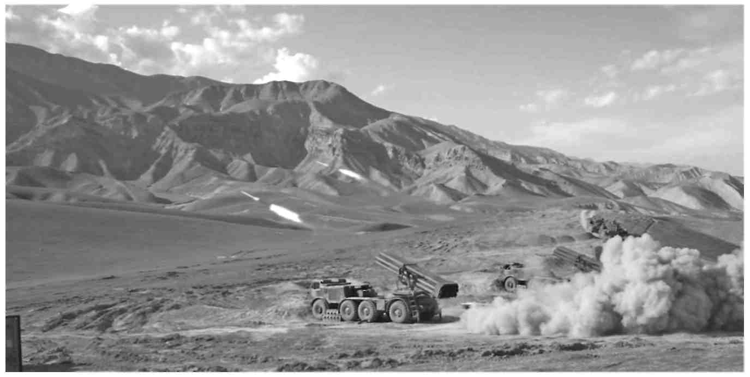
Fig. 1. Remote mining of a debouchment by an Uragan MLRS platoon
Standard targets of remote mining include control point elements; artillery battalions and batteries on the march; batteries (platoons) of field artillery in firing positions; tank (mechanized infantry and infantry companies) in assembly areas; battalions (companies) on the march and lines of deployment and departure; helicopters at landing sites; mobile field points of nuclear ammunition storage (conventional ammunition and fuel supply) and other assets.4
Moreover, if the area of a domestic armed conflict is being localized, the main mine actuation assets include: militants’ bases, training centers, and concentration areas; prepared strongholds and headquarters; infrastructure and life support assets important for irregular armed formations; narrow terrain corridors and debouchments.5
The high speed of laying a large number of mines is the main advantage of the method of remote mining of terrain. Modern assets make it possible in a few minutes to “plant killing devices” over a large territory, abruptly slow the pace of adversary attack, or completely close an avenue for the adversary.
These days, as a rule, two types of minefields are envisaged when conducting combined arms combat –protective and interdiction.6
Protective minefields are laid on terrain not occupied by adversary troops. They can be deliberately laid in areas of a possible advance by the adversary or directly in front of its subunits marching on a route or moving in battle formation. A protective minefield is deployed on one or several lines according to the rules of firing a stationary barrage by cannon artillery. The width of battalion and battery installation sites is specified at a rate of no more than 400 m (500 m for long-range major caliber rocket artillery) per combat vehicle. The near line of the protective minefield is specified taking into account the security of friendly forces.7
Fire support is called when the adversary approaches planned remote mining lines within 1,000 m (1,500 m for long-range major caliber rocket artillery).
Interdiction minefields are laid in the area (site) of adversary subunits and on routes of advance of its columns by covering all or some of the area of a stationary (moving) target with mines.8
It should be taken into account that during remote mining, mines are scattered without aiming. That is why they are easily found on the ground or a roadbed. In order to maximally hamper their detection and disposal, it is advisable to lay minefields on expected routes at night (under conditions of limited visibility) or by surprise against a moving column. In this case, the adversary column will have to stop in order to carry out reconnaissance and clear lanes in the minefield. A halt for 30-60 minutes will create favorable conditions for its fire damage. If the adversary decides to cross the minefield without reconnaissance, its losses can reach 20% to 40%. During a minefield laying operation, fire is called in at a given time or at the signal of a senior officer.
Interdiction minefields are laid on the advance routes of the adversary; impact points are selected according to the rules for destroying columns. Firing at each impact point involves no less than a rocket artillery platoon. MLRS subunits fire a salvo at assigned aiming points at one range elevation and one fire angle with a converged sheaf.9 MLRS systems capabilities for laying minefields are presented in the table.
It should be noted that the rejection of employing the 9M28K projectile, in our view, is premature, as there are no major caliber in brigade multiple launch rocket systems (motorized rifle [tank] formations have BM-21 or Tornado-G systems in service for which this projectile was developed).
Regulatory documents indicate that to determine the mode of shelling when laying a minefield, its minimal dimensions laterally and in depth are assumed to be: for Grad MLRS – 400 m, for Uragan MLRS – 500 to 600 m, and maximum dimensions should not exceed the values presented in the Table.10
At the same time, mean errors of the jet-propelled projectiles dispersion essentially exceed similar characteristics of rifled artillery. According to the artillery shooting theory, the following dependence is used to determine the dimensions of a uniform diffusion zone (UDZ) of jet-propelled projectiles: UDZ depth (front) increases proportionally to the extracted root of the sum of the reduced mean error of the projectiles dispersion in terms of the range (direction) and quantity of aiming points admitted in depth (laterally).
Table
220 mm MLRS Remote Mining Capabilities
| MLRS subunit | Parameters | Antitank minefield dimensions (m) | ||
| 220 mm rocket projectiles | ||||
| 9M59 | 9M27K2 (tanks) | 9M27K2 (IFV, APC) | ||
| Stationary and moving assets (interdiction minefields) | ||||
| Platoon | Front | 600 | ‒ | 600 |
| Depth | 600 | ‒ | 600 | |
| Battery | Front | 800 | ‒ | 800 |
| Depth | 600 | ‒ | 600 | |
| Battalion | Front | 1,200 | 800 | 1,200 |
| Depth | 1,200 | 800 | 1,200 | |
| In front of the advancing and attacking adversary or in the area of its expected operations (protective minefield) | ||||
| Platoon | Front | 1,600 | 700 | 1,600 |
| Depth | 600 | 600 | 600 | |
| Battery | Front | 3,200 | 1,400 | 3,200 |
| Depth | 600 | 600 | 600 | |
| Battalion | Front | 9,600 | 4,200 | 9,600 |
| Depth | 600 | 600 | 600 |
Note: In current local wars, BM-21 and Grad (9M28K projectile) multiple launch rocket systems have not been widely employed for remote mining of terrain. 9M27K2 projectiles have been removed from service in the RF Armed Forces but are widely used in present-day armed conflicts beyond Russia.
It follows from this dependence that in the event of converged rocket artillery shelling at one range elevation, the UDZ projectiles dimensions in depth and laterally will be 5.14 of the mean error of the projectiles dispersion in terms of range (direction).
Taking into account that reduced mean errors of the dispersion of a battery (battalion) are somewhat greater than dispersion errors of one combat vehicle, it could be argued that given shelling at one range elevation and a converged sheaf, a rocket artillery subunit can create a mining zone no less than five mean errors of the dispersion.11 It should be noted that in laying a minefield using the remote mining method, dispersion areas will be greater than estimated ones, and it is necessary to invariably take this factor into account in the process of plotting mine location maps, especially in the case of protective minefields.
The experience of conducting combat actions (operations) in Syria demonstrated the high efficiency of minefields remotely laid by MLRS. They have been termed duty minefields.
Duty minefields (DMF) are placed for a certain time (16-24 hours, up to the sterilization of antitank mines PTM-3 and PTM-1). They are laid to designate their location in a certain area. Unlike other types of minefields, it is advisable to lay a duty minefield in the daytime, because it is important to show it being laid. It is possible to use fewer fire weapons and projectiles, since the minefield density in this case does not play any role.
Practice showed that it is feasible to place DMF on unprotected (poorly protected) approaches to a stronghold of our (allied) troops. Moreover, it is possible to lay mines where adversary firepower is likely to appear, thus forcing the adversary to act within the framework of directions more convenient for own (allied) troops. If a DMF is laid, it becomes possible to determine with a relatively high degree of probability the composition of adversary forces and the direction of their actions in the subsequent 24 hours.12
Experience showed that it is expedient to use Grad, Tornado-G, or Uragan MLRS for laying duty minefields. It is primarily these systems that have a capability to execute the task with the required degree of accuracy, in a demonstrative manner, and at the appropriate time. In laying long-range remote minefields, 300 mm Smerch MLRS and 200 mm Uragan MLRS showed their efficiency13 Fig. 2 shows a Smerch MLRS laying a duty minefield.
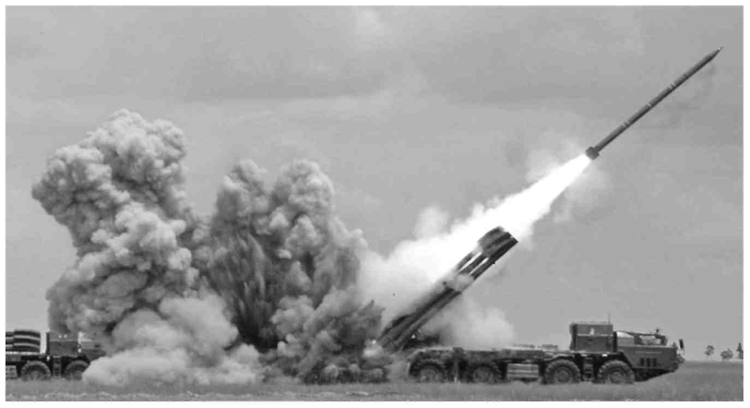
Fig. 2. Remote mining by a Smerch MLRS combat vehicle
At present, a Smerch MLRS with a 9M55K4 jet-propelled projectile (each contains 25 PTM-3 antitank mines) is the most efficient remote mining asset in terms of combat employment.14
The mine dispersion ellipse depends on flight trajectory and range and is approximately 2×2 km. To obtain a minefield of the required density 12 projectiles are needed, i.e., one full salvo by a Smerch MLRS combat vehicle.
Mines remain combat ready for 24 hours, after which they become sterile. If a mine is out of order or has not switched to combat ready status due to a wrong position, it is sterilized after 24 hours as well.
If a mine falls in close proximity to metal-consuming assets (vehicles, AMP, IFV), the explosion occurs immediately. A distance of approximately 300 m away from a minefield edge is the safest place for people at the moment of mine sterilization. PTM-3 mines can be cleared with the aid of EMT mine sweepers without waiting for their sterilization.15
The general view of a PTM-3 mine is presented in Fig. 3, and the installation of these mines in a front section of a Smerch MLRS is shown in in Fig 4.
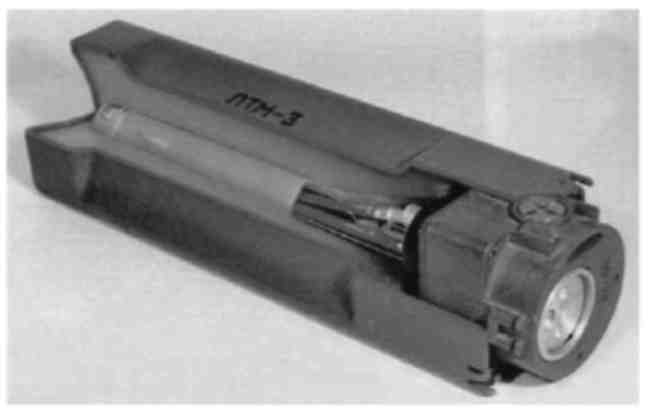
Fig. 3. PTM-3 mine
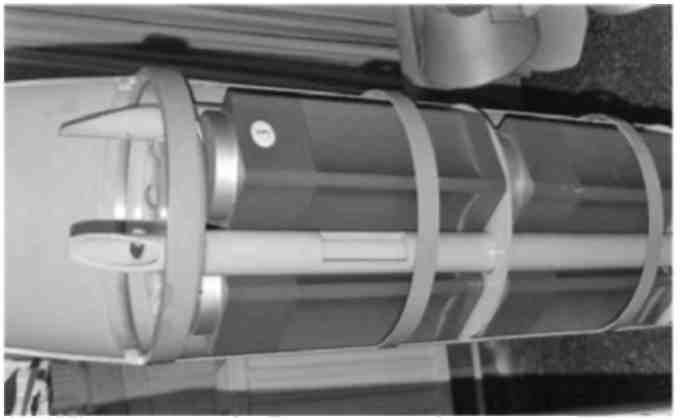
Fig. 4. Installation of PTM-3 mines in front section of a 300 mm 9M55K4 rocket projectile
A Smerch MLRS battalion can lay 3,600 mines of this type in one salvo at a range of up to 70 km. The total area of a minefield can reach 40 hectares and the distance between mines is not expected to exceed 13 m. Issues of marking a minefield and the availability of reconnaissance assets in the Missile Forces and Artillery structure that make it possible to assess its effectiveness are still unsolved. The employment of UAV that can be fired from one of the tubes jointly with Smerch MLRS 9M55K4 projectiles is one way to solve these problems.
At present, Uragan MLRS can employ 9M27K3 projectiles (with 312 PFM-1S antipersonnel mines).16 A PFM-1S mine is shown in Fig. 5. A 9M27K3 projectile demonstrated high combat characteristics in operational activity in Afghanistan while blocking armed gangs in base areas and on advance routes.
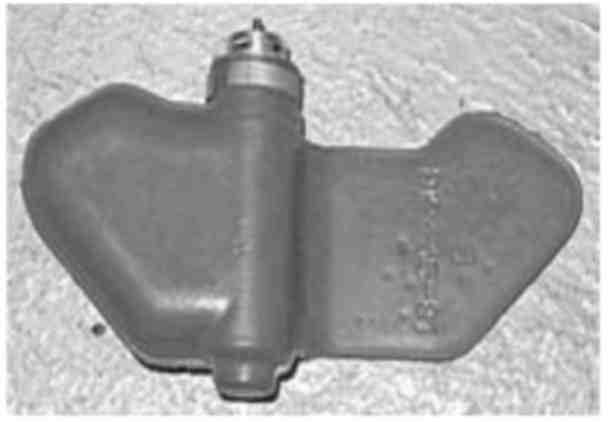
Fig. 5. PFM-1S mine
The practice of combat operations showed that the main aim of Missile Forces and Artillery remote mining is to prevent (slow) the adversary’s advance, and in a number of combat (operation) stages – to halt it for a certain time. The experience of the Great Patriotic War vividly demonstrates that minefields that were laid in combat unexpectedly on accurately identified advance routes of adversary troops proved to be the most effective.17 To block armed gangs in local wars and armed conflicts, debouchments, exits from base areas, and expected routes of withdrawal from blocking areas were remotely mined. Destruction was not a high priority. The factor of temporarily delaying the adversary’s movement was important. During the counterterrorism operation in the North Caucasus, remote mining was employed to protect areas through which militants and weapons were redeployed from foreign territories to Russia.18 The same tactics has been applied during the war in Syria, where roads and areas through which militants redeploy weapons, munitions, and personnel from neighboring countries and attempt to remove oil and petrochemicals have been mined.
At the same time, it should be noted that the damaging capacity of protective (interdiction) minefields without simultaneous fire damage to the halted adversary is extremely low. The experience of dismantling armed gangs shows that in a modern combined arms combat (operation), while developing a fire system, it is necessary to plan fire damage overlapping with the placed minefields involving not only fire weapons from covered fire positions but also the artillery assigned for direct fire, as well as aviation.
The trend of developing mines and mine laying devices is seen in their growing sophistication, but at the same time, their employment efficiency and flexibility is increasing. In recent years, the development and adoption of respective systems for service has intensified, as shown by the example of China, the United States, and Europe.
Consequently, today the development of mines, mine layers, and methods of laying minefields can be called a global trend. Remote mining of terrain by multiple launch rocket systems should also develop and improve in the RF Armed Forces in the interests of modern combined arms combat (operation).
NOTES:
1. V.I. Litvinenko and S.M. Yastrebov, Boyevoye primeneniye artilleriyi v sovremennom obshchevoyskovom boyu: ucheb. posobiye [Tactical Employment of Artillery in Modern Combined Arms Combat: A Manual], Knorus Publishers, Moscow, 2019, p. 24.
2. Ibid., p. 112.
3. Ibid., p. 214.
4. Ibid., p. 227.
5. Ibid., p. 278.
6. Ibid., p. 205.
7. V.I. Litvinenko, Taktika artilleriyi: ucheb. posobiye [Artillery Tactics: A Manual]. Knorus Publishers, Moscow, 2020, p. 178.
8. Ibid., p. 185.
9. Ibid., p. 193.
10. Ibid., p. 212.
11. D. Zhirnov and Ye. Timoshchuk, Oriyentiruyemsya na professionalov [Focus on Professionals], Armeyskiy sbornik, # 11, 2018, p. 42.
12. S.V. Gurov, Reaktivniye sistemy zalpovogo ognya [Multiple Launch Rocket Systems]. Peresvet Publishing House, Moscow, 2006, p. 165.
13. K. Kosarev, ‘Kalibry’na ‘Zemledeliyi’: kak rabotayet mashina distantsionnogo minirovaniya [How Remote Mining Vehicle Works], Zvezda, electronic resource. URL: http//tvzvezda.ru (Retrieved on July 7, 2020.)
14. Ibid.
15. S. Ruzakovsky, Reaktivniye snaryady distantsionnogo minirovaniya dlya RSZO ‘Grad’ [Remote Mining Rocket Projectiles for MLRS Grad], Voyennoye obozreniye. URL: http//topwar.ru (Retrieved on April 7, 2021.)
16. Ibid.
17. M.V. Pervov, Otechestvennoye raketnoye oruzhiye. Spravochnik [Russian Rocket Weapons. A Reference Book], OOO AKS-Konversalt, Moscow, 1999, p. 175.
18. Ibid., p. 54.